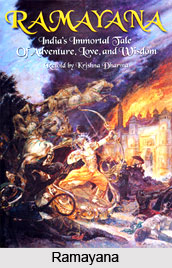 Epic Age in India is called so because it was during this age that the epics were composed in the subcontinent. It is estimated that the Epic period ranges from 1000 to 600 B.C. In the epics of Ramayana, Mahabharata and Upanishads, the ancient Indian society is explained in a very pictorial manner. These three Epics are not only a part of the mythological and religious scriptures, but also form an important ingredient of India`s historical roots.
Epic Age in India is called so because it was during this age that the epics were composed in the subcontinent. It is estimated that the Epic period ranges from 1000 to 600 B.C. In the epics of Ramayana, Mahabharata and Upanishads, the ancient Indian society is explained in a very pictorial manner. These three Epics are not only a part of the mythological and religious scriptures, but also form an important ingredient of India`s historical roots.
Among the two epics of Mahabharata and Ramayana, the Mahabharata and the Ramayana are the two most famous epics. According to certain scholars, both the Indian epics can be counter pointed with `Iliad` and `Odyssey`, the Greek epics which are composed by Homer. Rishi Valmiki wrote Ramayana and is considered to be the oldest and the most-admired epic. Ved Vyas wrote Mahabharata. There is a great difference in the opinions of the scholars with regard to the exact date of composition of these two epics. As per religious tradition, the two epics were composed approximately in the 3000 B.C. As per Macdonell, they were composed around 500 to 200 B.C and according to Dr. Radha Kumud Mookherjee the epics were written some where around 1500 to 600 B.C. at the time of the rise of Buddhism and Jainism. Some of the modern scholars are of the view that the grand epic of Mahabharata is not the work of a single writer (Ved Vyas), but probably an end product of a number of writers.
The prominent political set up of the epic age was the expansion of kingdoms, which happened in substitution of a number of small kingdoms which existed at the time of the Vedic period. The sacred religious activities of the epic age outlined the religious condition of that era. Apart from the Vedic gods and goddesses the worship of Lord Shiva, Lord Vishnu and Shakti were introduced.
 The social condition of the epic age include the caste system which became very severe and society was divided into four castes; Brahman, Kshatriyas, Vaishyas and Shudras. The works of all the four castes were fixed. At that time, people lived in fortified camps. No big cities were there, and kingship became hereditary. Taxes were levied by the royalty on his subjects. Sacrifices alongwith a list of rituals formed the central attraction of religious ceremonies and the Brahman gained in power. A number of symbolic objects came to be worshipped and signs of idol worship were observed later. Agriculture became the prominent source of living for the people of the epic age and remarkable development in agriculture is seen in this period.
The social condition of the epic age include the caste system which became very severe and society was divided into four castes; Brahman, Kshatriyas, Vaishyas and Shudras. The works of all the four castes were fixed. At that time, people lived in fortified camps. No big cities were there, and kingship became hereditary. Taxes were levied by the royalty on his subjects. Sacrifices alongwith a list of rituals formed the central attraction of religious ceremonies and the Brahman gained in power. A number of symbolic objects came to be worshipped and signs of idol worship were observed later. Agriculture became the prominent source of living for the people of the epic age and remarkable development in agriculture is seen in this period.












